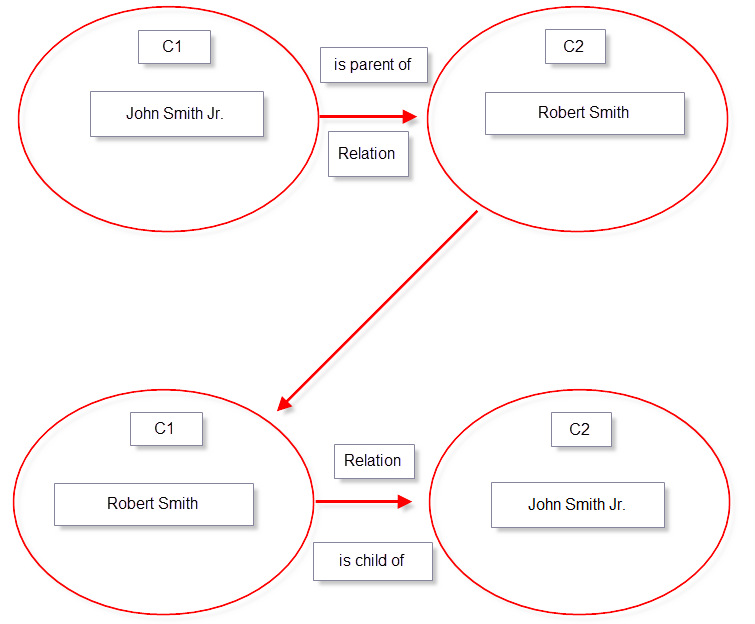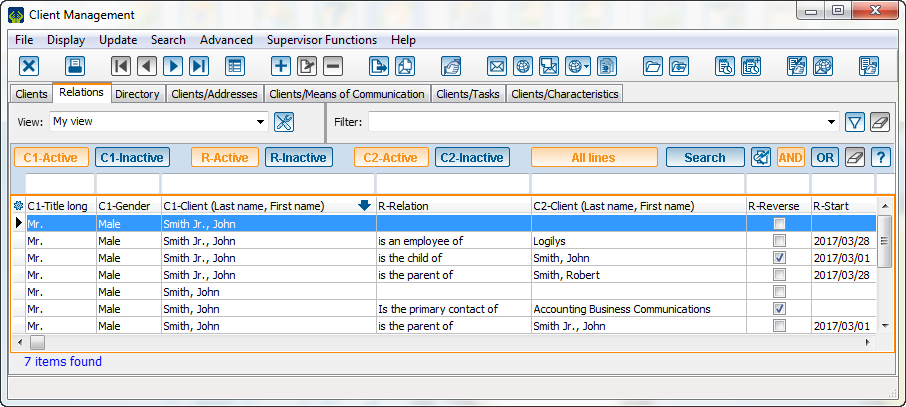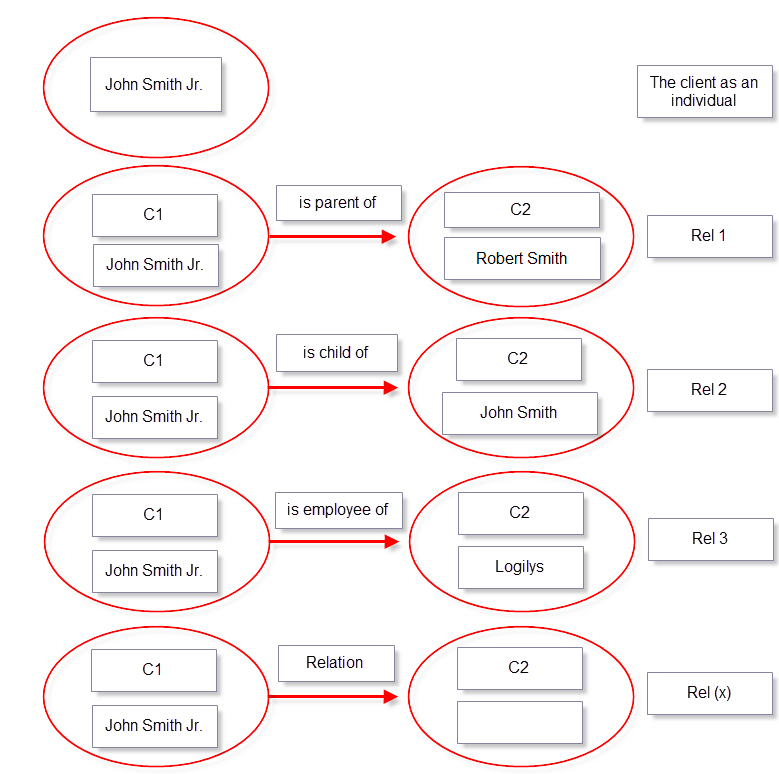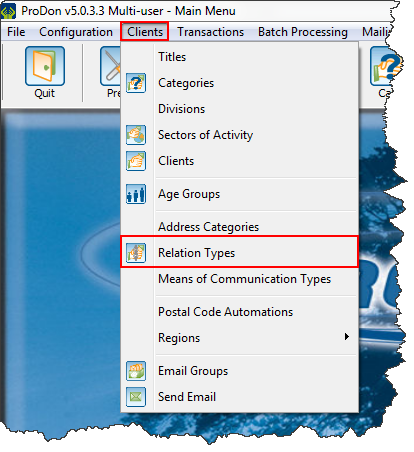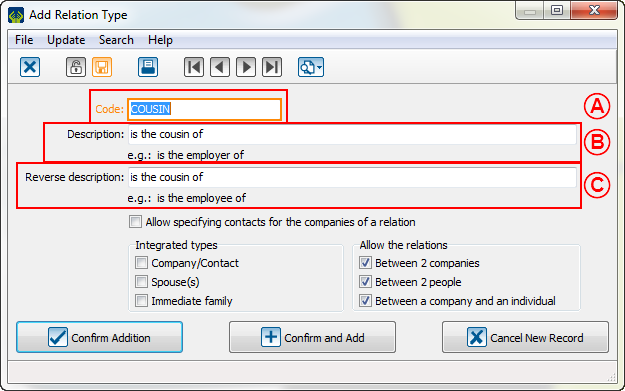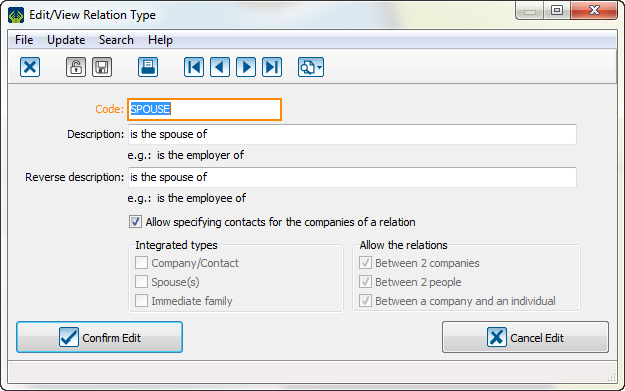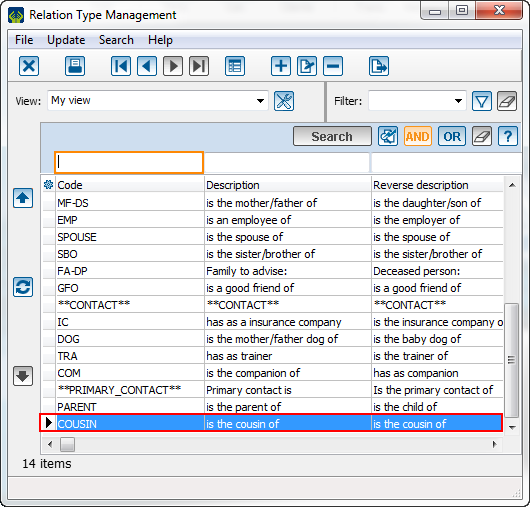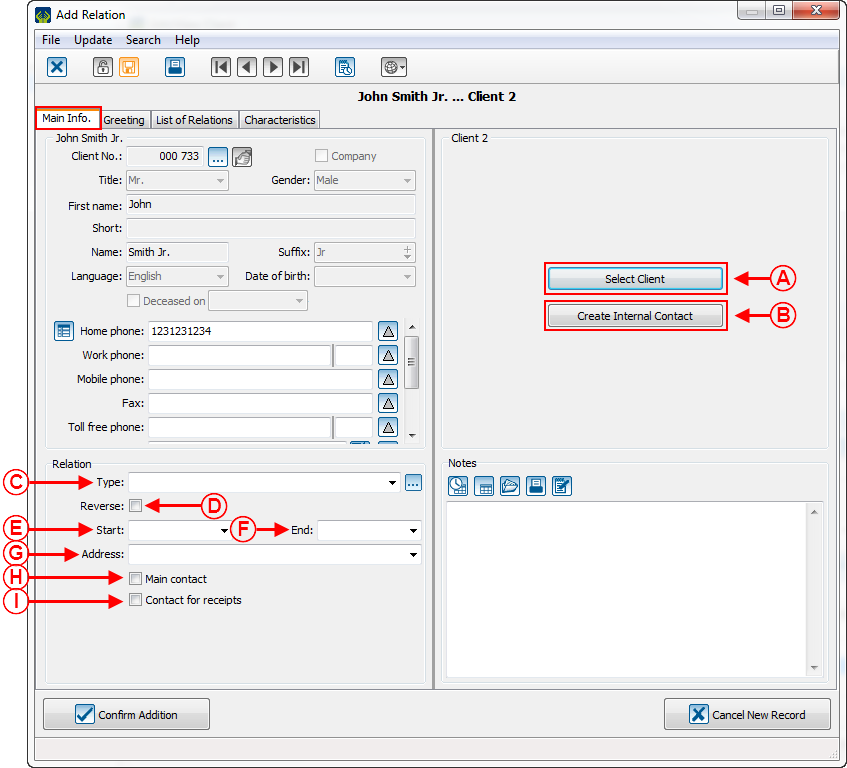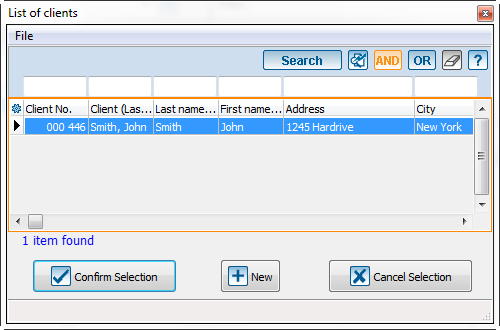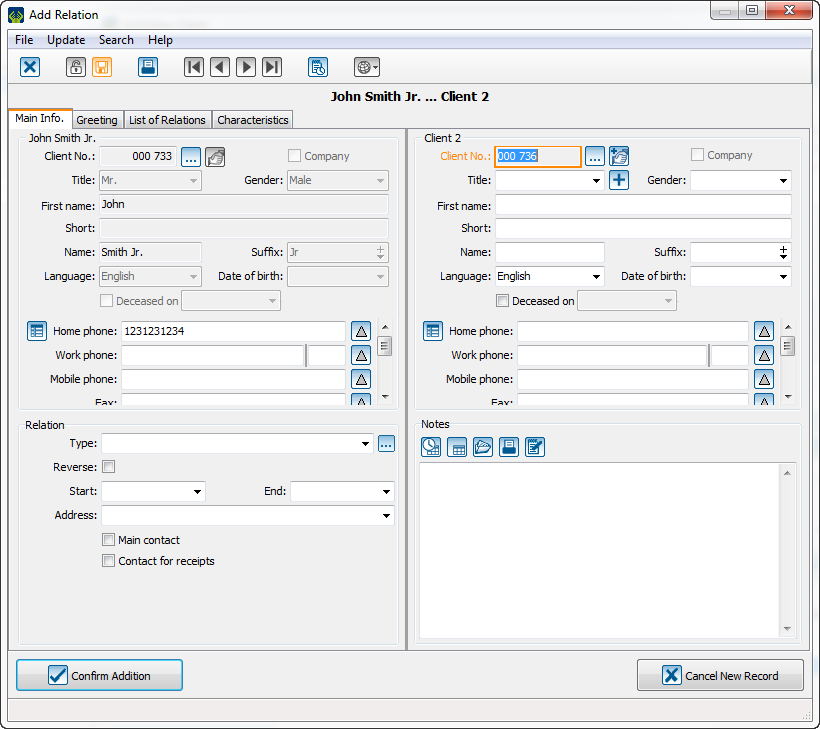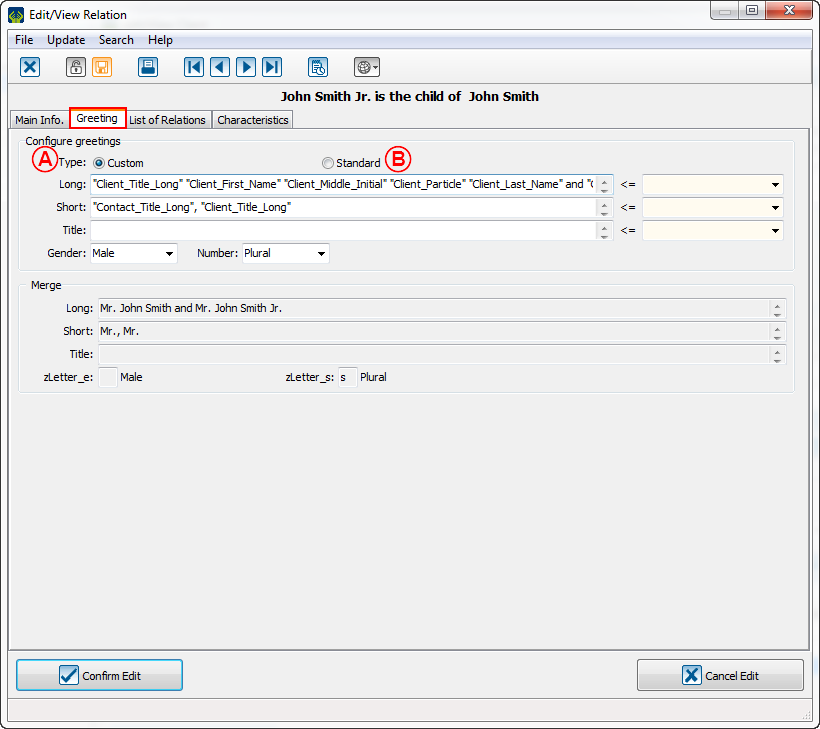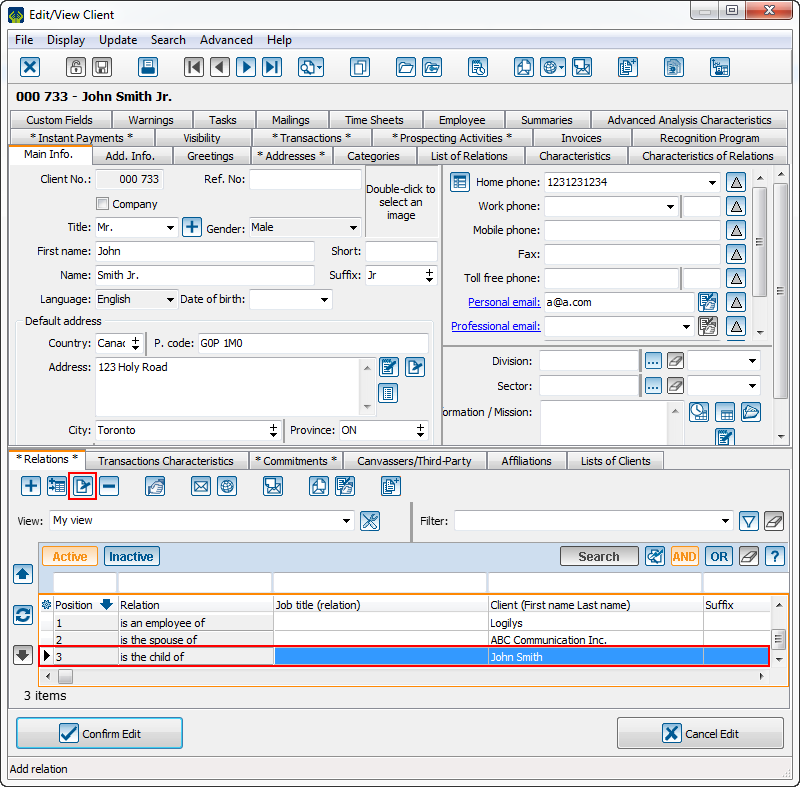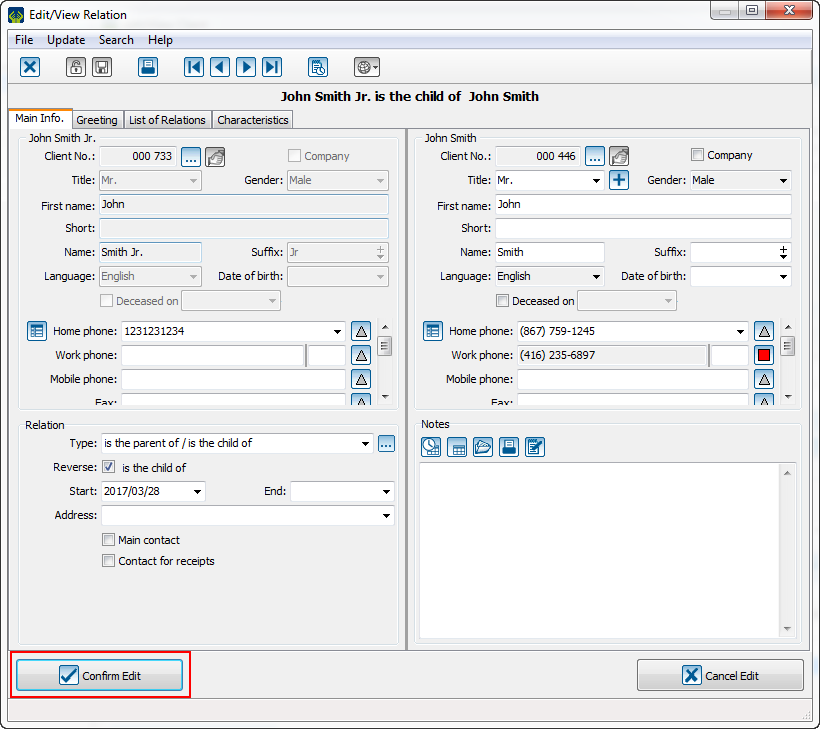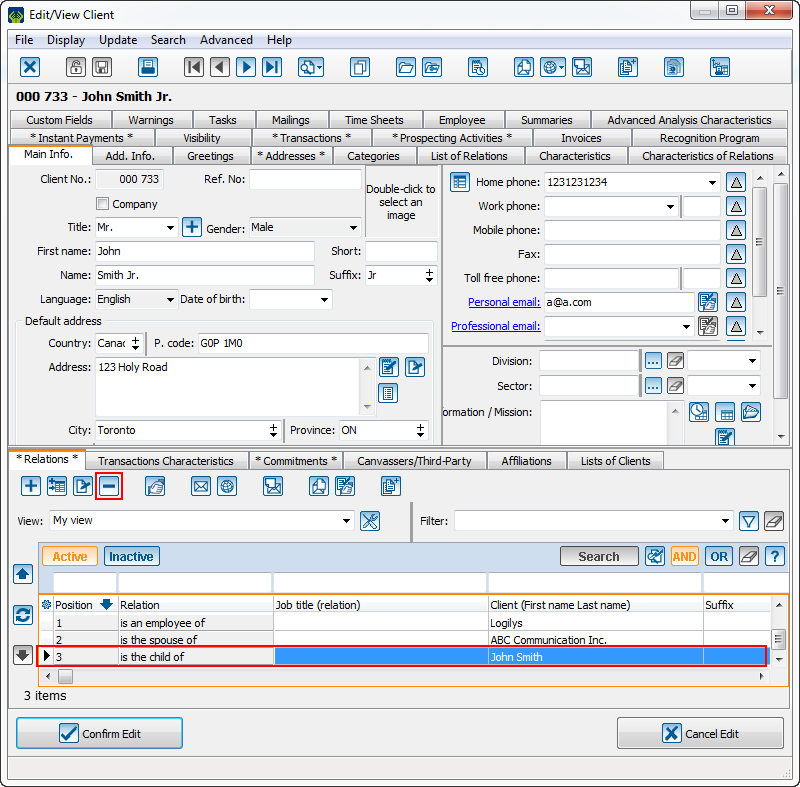Difference between revisions of "ProDon:Relations"
Jguillemette (talk | contribs) (→Edit a relation) |
Jguillemette (talk | contribs) |
||
| Line 6: | Line 6: | ||
The relations are the contact network within ProDon. From this function, it is possible to link contacts to their organization, their family, their friends and their acquaintances. Furthermore, ProDon keeps a memory because it is important to be able to redraw the contact network of clients and organizations. The relations are also important because they are linked to the mass mailing and E-mail blast. | The relations are the contact network within ProDon. From this function, it is possible to link contacts to their organization, their family, their friends and their acquaintances. Furthermore, ProDon keeps a memory because it is important to be able to redraw the contact network of clients and organizations. The relations are also important because they are linked to the mass mailing and E-mail blast. | ||
| − | |||
== The Relation concept == | == The Relation concept == | ||
A relation is the link between 2 entities. These entities can be individuals or companies. These links are depicted by Client 1 (C1) is linked to Client 2 (C2). | A relation is the link between 2 entities. These entities can be individuals or companies. These links are depicted by Client 1 (C1) is linked to Client 2 (C2). | ||
| − | |||
| − | |||
{| width="25%" cellspacing="1" cellpadding="1" border="1" class="wikitable" | {| width="25%" cellspacing="1" cellpadding="1" border="1" class="wikitable" | ||
| Line 34: | Line 31: | ||
|} | |} | ||
| − | From a | + | From a theoretical perspective, a relation should be shown as followed: |
| − | + | <br> | |
[[File:ProDon5_Relation_Relation_concept_001.png]] <br> | [[File:ProDon5_Relation_Relation_concept_001.png]] <br> | ||
Here are the results with examples: | Here are the results with examples: | ||
| − | |||
1) If C1 is an individual and C2 is also an individual: | 1) If C1 is an individual and C2 is also an individual: | ||
| − | + | <br> | |
[[File:ProDon5_Relation_Relation_concept_002.png]] <br> | [[File:ProDon5_Relation_Relation_concept_002.png]] <br> | ||
2) If C1 is an individual and C2 is a company: | 2) If C1 is an individual and C2 is a company: | ||
| − | + | <br> | |
[[File:ProDon5_Relation_Relation_concept_005.png]] <br> | [[File:ProDon5_Relation_Relation_concept_005.png]] <br> | ||
3) If C1 is a company and C2 is an individual: | 3) If C1 is a company and C2 is an individual: | ||
| − | + | <br> | |
[[File:ProDon5_Relation_Relation_concept_003.png]] <br> | [[File:ProDon5_Relation_Relation_concept_003.png]] <br> | ||
4) If C1 is a company and C2 is also a company: | 4) If C1 is a company and C2 is also a company: | ||
| − | + | <br> | |
[[File:ProDon5_Relation_Relation_concept_004.png]] <br> | [[File:ProDon5_Relation_Relation_concept_004.png]] <br> | ||
| − | Please note that even if a relation is '''''MUTUAL''''', it must be read from C1 to C2: <br> | + | Please note that even if a relation is '''''MUTUAL''''', it must always be read from C1 to C2: <br> |
| − | + | ||
[[File:ProDon5_Relation_Relation_concept_006.png]] <br> | [[File:ProDon5_Relation_Relation_concept_006.png]] <br> | ||
| + | |||
So, with a example from the relation tab of the client management of ProDon: | So, with a example from the relation tab of the client management of ProDon: | ||
| − | + | <br> | |
[[File:ProDon5_Relation_Relation_concept_007.png]] <br> | [[File:ProDon5_Relation_Relation_concept_007.png]] <br> | ||
One should understand this: | One should understand this: | ||
| − | + | <br> | |
[[File:ProDon5_Relation_Relation_concept_008.png]] <br> | [[File:ProDon5_Relation_Relation_concept_008.png]] <br> | ||
| Line 75: | Line 72: | ||
== Add a relation type == | == Add a relation type == | ||
To add a relation type, go to the "Client" tab of the homepage and click on "Relation types". | To add a relation type, go to the "Client" tab of the homepage and click on "Relation types". | ||
| − | |||
| − | |||
[[File:ProDon5_Relations_Add_a_relation_type_001.png]] | [[File:ProDon5_Relations_Add_a_relation_type_001.png]] | ||
| Line 82: | Line 77: | ||
{| width="25%" cellspacing="1" cellpadding="1" border="1" class="wikitable" | {| width="25%" cellspacing="1" cellpadding="1" border="1" class="wikitable" | ||
| colspan="2" | This window will open: | | colspan="2" | This window will open: | ||
| − | + | ||
|- | |- | ||
| colspan="2" | [[File:ProDon5_Relations_Add_a_relation_type_002.png]] | | colspan="2" | [[File:ProDon5_Relations_Add_a_relation_type_002.png]] | ||
|- | |- | ||
| width="50%" | | | width="50%" | | ||
| − | Click on the | + | Click on the [[File:Button_add_plus.png]] button to add a relation type, on the [[File:Edit_button.png]] button to edit and on the [[File:Button_Minus_remove_delete.png]] button to remove a relation type. |
| − | |||
|} | |} | ||
{| width="25%" cellspacing="1" cellpadding="1" border="1" class="wikitable" | {| width="25%" cellspacing="1" cellpadding="1" border="1" class="wikitable" | ||
| colspan="2" | Then, this window will open: | | colspan="2" | Then, this window will open: | ||
| − | |||
|- | |- | ||
| colspan="2" | [[File:ProDon5_Relations_Add_a_relation_type_003.png]] | | colspan="2" | [[File:ProDon5_Relations_Add_a_relation_type_003.png]] | ||
| Line 99: | Line 92: | ||
| width="50%" | | | width="50%" | | ||
<span style="color: rgb(255, 0, 0);">'''A:'''</span> The "Code" section is used to name a relation. | <span style="color: rgb(255, 0, 0);">'''A:'''</span> The "Code" section is used to name a relation. | ||
| − | |||
| − | |||
| <span style="color: rgb(255, 0, 0);">'''B:'''</span> The "Description" section is used to explain the link from client 1 to client 2. | | <span style="color: rgb(255, 0, 0);">'''B:'''</span> The "Description" section is used to explain the link from client 1 to client 2. | ||
| − | |||
|- | |- | ||
| colspan="2" | <span style="color: rgb(255, 0, 0);">'''C:'''</span> The "Reverse description" section is used to explain the link from client 2 to client 1. | | colspan="2" | <span style="color: rgb(255, 0, 0);">'''C:'''</span> The "Reverse description" section is used to explain the link from client 2 to client 1. | ||
| − | + | ||
|} | |} | ||
The "Integrated types" section shows preset configurations for a relation. | The "Integrated types" section shows preset configurations for a relation. | ||
| − | |||
{| width="25%" cellspacing="1" cellpadding="1" border="1" class="wikitable" | {| width="25%" cellspacing="1" cellpadding="1" border="1" class="wikitable" | ||
| Line 117: | Line 106: | ||
| width="50%" | | | width="50%" | | ||
<span style="color: rgb(255, 0, 0);">'''A:'''</span> When the option "Company/Contact" is checked, automatically the options of the section "Allow the relations" are checked. The context where this option must be selected is when new relation type must be limited to a company and an individual. | <span style="color: rgb(255, 0, 0);">'''A:'''</span> When the option "Company/Contact" is checked, automatically the options of the section "Allow the relations" are checked. The context where this option must be selected is when new relation type must be limited to a company and an individual. | ||
| − | |||
| − | |||
| <span style="color: rgb(255, 0, 0);">'''B:'''</span> Please observe that by selecting this potion in the "Integrated types", the other options of the same section and also the section "Allow the relations" become locked. | | <span style="color: rgb(255, 0, 0);">'''B:'''</span> Please observe that by selecting this potion in the "Integrated types", the other options of the same section and also the section "Allow the relations" become locked. | ||
| − | |||
| − | |||
|} | |} | ||
| Line 130: | Line 115: | ||
| width="50%" | | | width="50%" | | ||
<span style="color: rgb(255, 0, 0);">'''A:'''</span> When the option "Spouse(s)" is checked, automatically the options of the section "Allow the relations" and the "Immediate family" box are checked. The context where this option must be selected is when new relation type must be limited to two persons that are in couple. | <span style="color: rgb(255, 0, 0);">'''A:'''</span> When the option "Spouse(s)" is checked, automatically the options of the section "Allow the relations" and the "Immediate family" box are checked. The context where this option must be selected is when new relation type must be limited to two persons that are in couple. | ||
| − | |||
| − | |||
| <span style="color: rgb(255, 0, 0);">'''B:'''</span> Please observe that by selecting this potion in the "Integrated types", the other options of the same section and also the section "Allow the relations" become locked. | | <span style="color: rgb(255, 0, 0);">'''B:'''</span> Please observe that by selecting this potion in the "Integrated types", the other options of the same section and also the section "Allow the relations" become locked. | ||
| − | |||
| − | |||
|} | |} | ||
| Line 144: | Line 125: | ||
<span style="color: rgb(255, 0, 0);">'''A:'''</span> When the option "Immediate family" is checked, automatically the options of the section "Allow the relations" are checked. The context where this option must be selected is when new relation type must be limited to two persons that are from the same family. | <span style="color: rgb(255, 0, 0);">'''A:'''</span> When the option "Immediate family" is checked, automatically the options of the section "Allow the relations" are checked. The context where this option must be selected is when new relation type must be limited to two persons that are from the same family. | ||
| − | |||
| <span style="color: rgb(255, 0, 0);">'''B:'''</span> Please observe that by selecting this potion in the "Integrated types", the other options of the same section and also the section "Allow the relations" become locked. | | <span style="color: rgb(255, 0, 0);">'''B:'''</span> Please observe that by selecting this potion in the "Integrated types", the other options of the same section and also the section "Allow the relations" become locked. | ||
| − | |||
| − | |||
|} | |} | ||
The "Allow the relations" section allows the customization of the configuration of the relation types. | The "Allow the relations" section allows the customization of the configuration of the relation types. | ||
| − | |||
{| width="25%" cellspacing="1" cellpadding="1" border="1" class="wikitable" | {| width="25%" cellspacing="1" cellpadding="1" border="1" class="wikitable" | ||
| Line 159: | Line 136: | ||
| width="50%" | | | width="50%" | | ||
<span style="color: rgb(255, 0, 0);">'''A:'''</span> When the option "Between 2 companies" is checked, the relation will be able to be set between 2 companies. | <span style="color: rgb(255, 0, 0);">'''A:'''</span> When the option "Between 2 companies" is checked, the relation will be able to be set between 2 companies. | ||
| − | |||
| <span style="color: rgb(255, 0, 0);">'''B:'''</span> When the option "Between 2 individuals" is checked, the relation will be able to be set between 2 individuals. | | <span style="color: rgb(255, 0, 0);">'''B:'''</span> When the option "Between 2 individuals" is checked, the relation will be able to be set between 2 individuals. | ||
| − | |||
|- | |- | ||
| colspan=2 |<span style="color: rgb(255, 0, 0);">'''C:'''</span> When the option "Between a company and an individual" is checked, the relation will be able to be set between a company and an individual. | | colspan=2 |<span style="color: rgb(255, 0, 0);">'''C:'''</span> When the option "Between a company and an individual" is checked, the relation will be able to be set between a company and an individual. | ||
| − | |||
|} | |} | ||
== Edit a relation type == | == Edit a relation type == | ||
| − | Ideally, a relation type should be edited before creating a relation that will be using it because the used sections will be locked. It is mostly identical to the addition of a relation type: it is possible to edit the "Code", the "Description", the "Reverse description", the "Integrated types" options and the "Allow the relations" section. To do so, select the relation to edit and click on the | + | Ideally, a relation type should be edited before creating a relation that will be using it because the used sections will be locked. It is mostly identical to the addition of a relation type: it is possible to edit the "Code", the "Description", the "Reverse description", the "Integrated types" options and the "Allow the relations" section. To do so, select the relation to edit and click on the [[File:Edit_button.png]] button. |
| − | |||
| − | |||
| − | |||
| − | |||
| − | |||
'''''CAUTION!''''' | '''''CAUTION!''''' | ||
| − | |||
In the following example, the relation has been configured in function that everything could be spouse of everything. | In the following example, the relation has been configured in function that everything could be spouse of everything. | ||
| − | |||
| − | |||
[[File:ProDon5_Relations_Edit_a_relation_type_001.png]] | [[File:ProDon5_Relations_Edit_a_relation_type_001.png]] | ||
| − | So, it | + | So, it creates cases like these: |
| − | |||
{| width="40%" cellspacing="1" cellpadding="1" border="1" class="wikitable" | {| width="40%" cellspacing="1" cellpadding="1" border="1" class="wikitable" | ||
| Line 213: | Line 178: | ||
So, because there is already existing cases that imply all possibilities in this ProDon database, it is not possible to edit this relation example before adjusting all relations using this relation type first. Please be cautious to not create a/an catch-all/holdall relation. | So, because there is already existing cases that imply all possibilities in this ProDon database, it is not possible to edit this relation example before adjusting all relations using this relation type first. Please be cautious to not create a/an catch-all/holdall relation. | ||
| − | |||
| − | |||
== Remove a relation type == | == Remove a relation type == | ||
It is possible to remove the relation types that are not used anymore. If the type is still used, the software will block the removal. | It is possible to remove the relation types that are not used anymore. If the type is still used, the software will block the removal. | ||
| − | |||
| − | |||
Please select the relation type that must be removed and select the - button in the Relation type management. | Please select the relation type that must be removed and select the - button in the Relation type management. | ||
Revision as of 16:42, 28 March 2017
| Relations |
CAUTION: This document is currently being revised, it may be possible that some parts are missing or outdated
Introduction
The relations are the contact network within ProDon. From this function, it is possible to link contacts to their organization, their family, their friends and their acquaintances. Furthermore, ProDon keeps a memory because it is important to be able to redraw the contact network of clients and organizations. The relations are also important because they are linked to the mass mailing and E-mail blast.
The Relation concept
A relation is the link between 2 entities. These entities can be individuals or companies. These links are depicted by Client 1 (C1) is linked to Client 2 (C2).
| Possible type of relations | |
|
C1 |
C2 |
| Individual | Individual |
| Individual | Company |
| Company | Individual |
| Company | Company |
From a theoretical perspective, a relation should be shown as followed:
Here are the results with examples:
1) If C1 is an individual and C2 is also an individual:

2) If C1 is an individual and C2 is a company:
3) If C1 is a company and C2 is an individual:
4) If C1 is a company and C2 is also a company:
Please note that even if a relation is MUTUAL, it must always be read from C1 to C2:
So, with a example from the relation tab of the client management of ProDon:
One should understand this:
Add a relation type
To add a relation type, go to the "Client" tab of the homepage and click on "Relation types".
| This window will open: | |
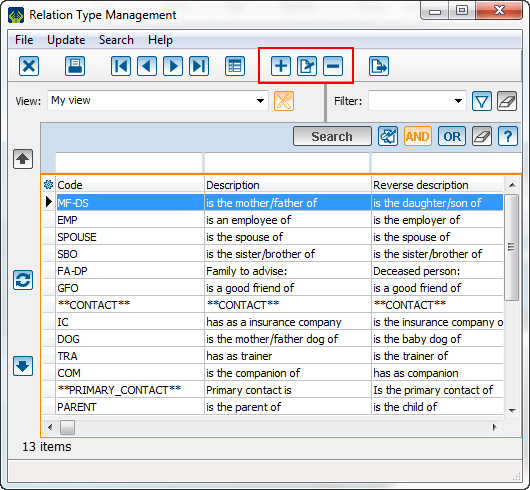
| |
|
Click on the | |
The "Integrated types" section shows preset configurations for a relation.
The "Allow the relations" section allows the customization of the configuration of the relation types.
Edit a relation type
Ideally, a relation type should be edited before creating a relation that will be using it because the used sections will be locked. It is mostly identical to the addition of a relation type: it is possible to edit the "Code", the "Description", the "Reverse description", the "Integrated types" options and the "Allow the relations" section. To do so, select the relation to edit and click on the ![]() button.
button.
CAUTION!
In the following example, the relation has been configured in function that everything could be spouse of everything.
So, it creates cases like these:
| Possible relations from this template | ||
| C1 | Relation | C2 |
| Individual | is spouse of | Individual |
| Individual | is spouse of | Company |
| Company | is spouse of | Individual |
| Company | is spouse of | Company |
So, because there is already existing cases that imply all possibilities in this ProDon database, it is not possible to edit this relation example before adjusting all relations using this relation type first. Please be cautious to not create a/an catch-all/holdall relation.
Remove a relation type
It is possible to remove the relation types that are not used anymore. If the type is still used, the software will block the removal.
Please select the relation type that must be removed and select the - button in the Relation type management.
Il faut sélectionner le type de relation qu'il faut retirer et appuyer sur le bouton ![]() dans la gestion des types de relation.
dans la gestion des types de relation.
Then, click on "Confirm deletion" to finish the operation.
Ensuite, il faut appuyer sur « Confirmer le retrait » pour finaliser l'opération.
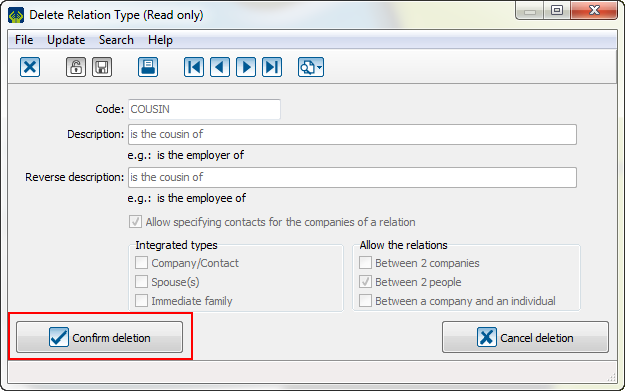
Add a relation
To add a relation, go to the relation tab of a client's file. Pour ajouter une relation, il faut aller dans l'onglet relation de la fiche d'un client.
The "Main info" tab
| Press on the + button to add a relation. | |
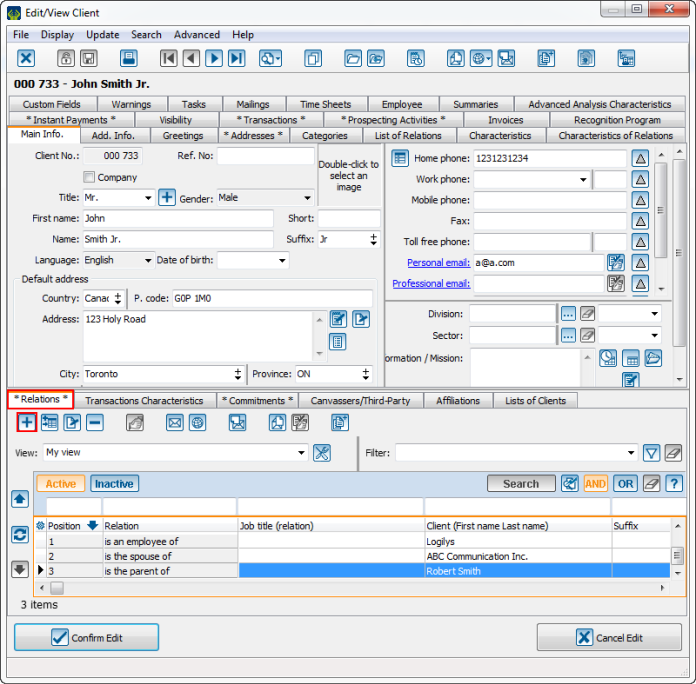
|
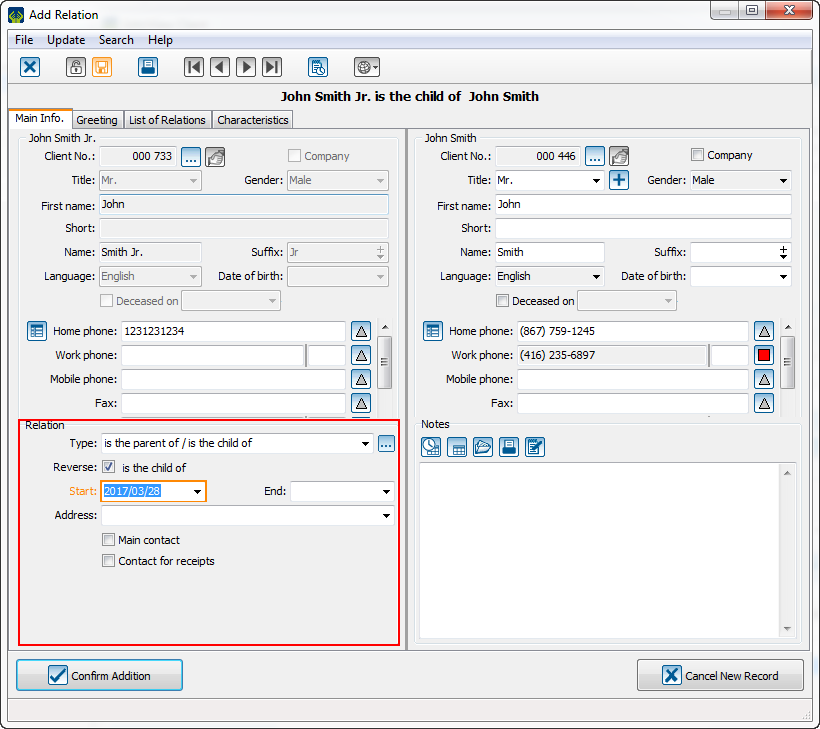
| |
| Then, the user will have to complete the relation section.
Il faudra ensuite compléter la section relation. |
The "Greeting" tab
It is possible to customize the greetings or it is possible to use the standard greetings.
Il est possible de personnaliser les salutations ou il est possible d'utiliser les salutations standards.
Edit a relation
To edit a relation, go to the relation tab of the client file, position on the relation that need to be edited and click on the EDIT button or double-click on the relation.
Pour modifier une relation, il faut aller dans l'onglet relation de la fiche client, se positionner sur la relation à modifier et appuyer sur le bouton ![]() ou double-cliquer sur la relation.
ou double-cliquer sur la relation.
NOTE: To archive a relation, set it an end date. So, the organization will be able to keep traces in its database inactive relations. To see them, go to the relation tab of the client management and click on the ![]() button.
button.
Pour archiver une relation, il faut lui mettre une date de fin. Alors, de cette manière, l'organisation pourra garder une trace dans sa base de donnée des relations qui ne sont plus actives. Pour les voir, il faudra aller dans l'onglet relation de la gestion des clients et cliquer sur le bouton Bouton R-Inactive.png.
Delete a relation
To delete a relation, go to the relation tab of the client file, position on the relation to delete and click on the - button.
Pour retirer une relation, il faut aller dans l'onglet relation de la fiche client, se positionner sur la relation à retirer et appuyer sur le bouton ![]() .
.
| Then, click on the "Confirm Deletion" to delete the link between these clients.
Ensuite, il faut cliquer sur « Confirmer le retrait » pour retirer le lien entre les clients. | |
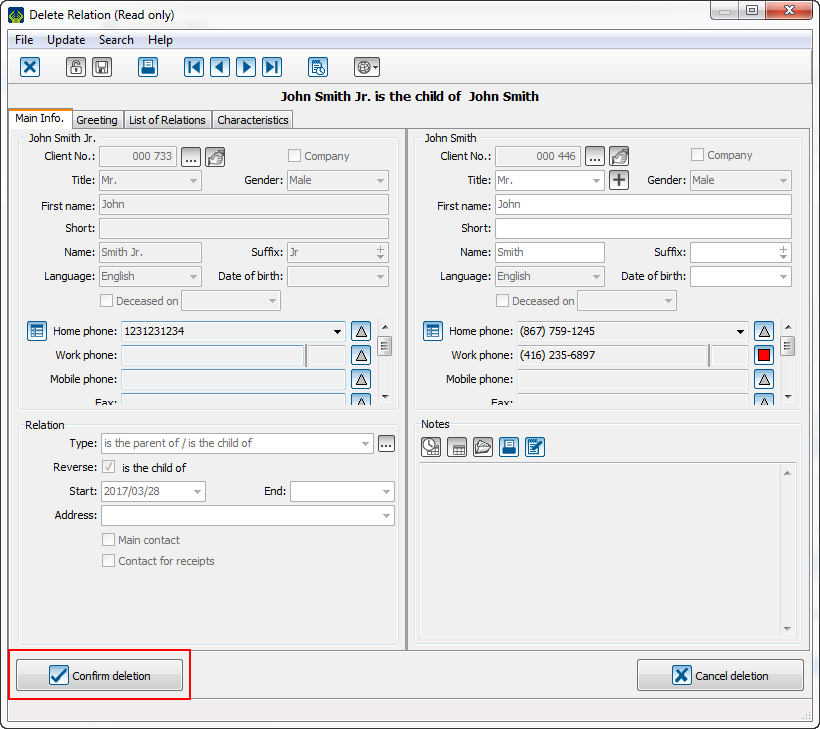
| |
Document name: ProDon:Relations
Version : 5.0.3.3




